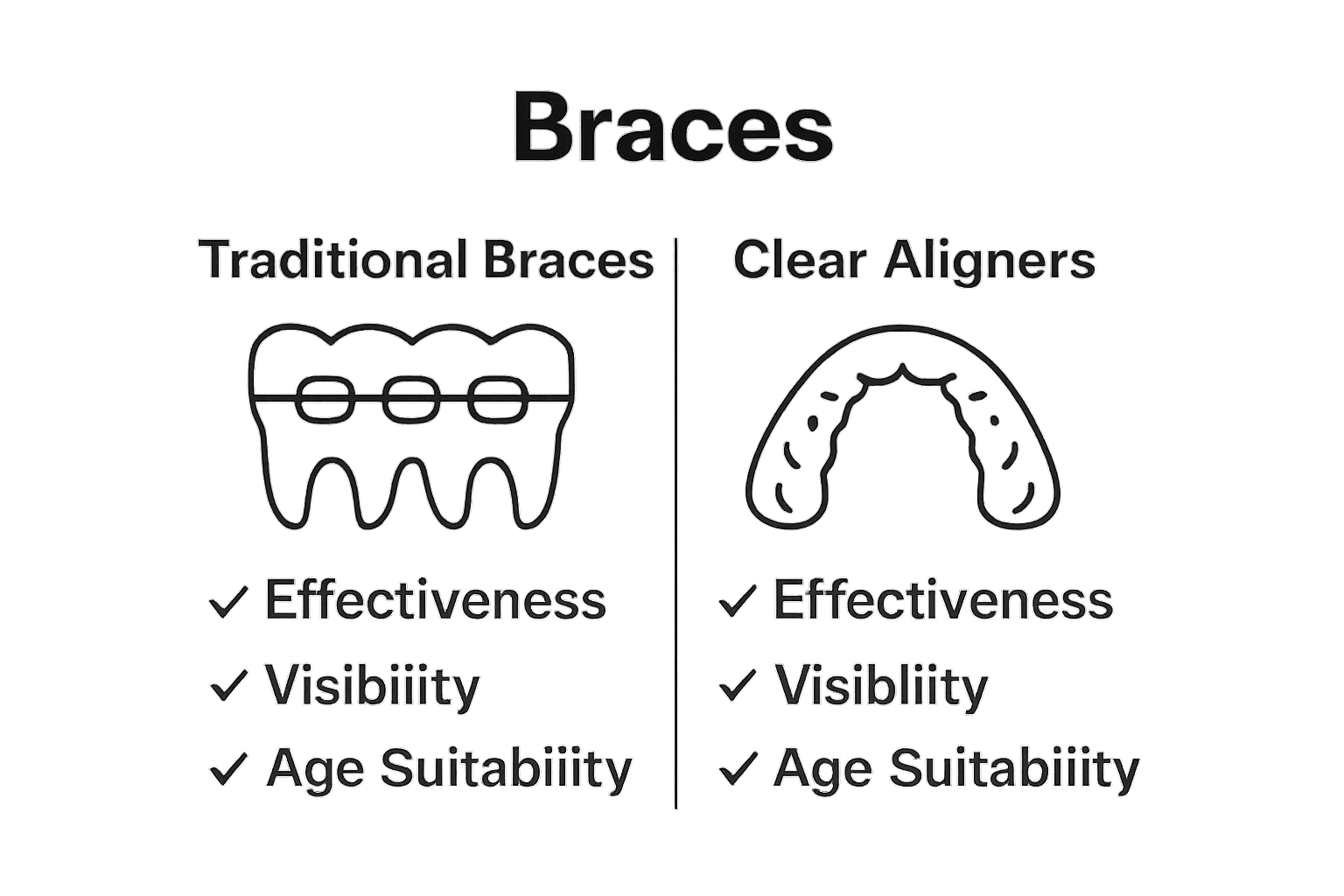Understanding the Best Age for Braces: Key Insights
September 28, 2025
Understanding the Best Age for Braces: Key Insights
Braces are a common sight in dental offices, and chances are you know someone who has worn them at some point. Most people assume braces are just for straightening teeth, but the story is much bigger. About 75 percent of kids could benefit from some type of orthodontic care according to the American Association of Orthodontists. While you might think the main purpose is a better smile, braces can actually shape your jaw, fix bite issues, and prevent long-term dental problems—often making a real difference beyond what you see in the mirror.
Table of Contents
- What Are Braces And Their Purpose?
- Why Timing Matters: Understanding Dental Development
- The Ideal Age Range For Braces: Key Factors
- How Orthodontics Works: What To Expect
- Exploring Options: Traditional Braces Vs. Clear Aligners
Quick Summary
| Takeaway | Explanation |
|---|---|
| Braces correct dental misalignments | Braces are essential for repositioning teeth and solving structural dental issues to improve oral health. |
| Early assessments are crucial | Identifying alignment problems early can simplify future treatment and reduce complexity in orthodontic care. |
| Optimal age for braces is 10-14 | Preteen and early teenage years are best for braces due to ongoing jaw and dental growth, ensuring effective treatment. |
| Understand treatment options | Patients can choose between traditional braces and clear aligners, each with unique benefits depending on their dental needs. |
| Regular monitoring is necessary | Frequent check-ups allow orthodontists to adjust treatment plans to ensure effective and comfortable tooth movement. |
What Are Braces and Their Purpose?
Braces represent a specialized orthodontic treatment designed to correct dental misalignments and improve overall oral health. These precision devices work systematically to reposition teeth and address complex dental structural issues that impact both aesthetics and functionality.
Understanding the Core Function of Braces
At their fundamental level, braces are mechanical systems composed of brackets, wires, and sometimes additional components like rubber bands that apply consistent, gentle pressure to teeth. This controlled pressure gradually shifts teeth into their optimal alignment. Orthodontists carefully design these systems to address various dental challenges, including crooked teeth, overcrowding, gaps between teeth, and bite misalignments.
The mechanism behind braces involves applying strategic pressure that stimulates bone remodeling. As pressure is applied, the bone surrounding the tooth temporarily softens, allowing the tooth to move into a new position. Over time, new bone tissue forms around the tooth in its corrected location, effectively stabilizing the new alignment.
Types of Dental Issues Addressed by Braces
Braces are not merely cosmetic solutions but critical interventions for numerous dental health concerns. According to the American Association of Orthodontists, braces can effectively address several complex dental conditions:
- Malocclusion (improper bite)
- Severe crowding of teeth
- Significant spacing between teeth
- Jaw misalignment
- Potential speech impediments caused by dental structure
By correcting these issues, braces contribute to improved oral hygiene, reduce the risk of tooth decay, and can prevent long-term complications related to misaligned dental structures. Patients who undergo orthodontic treatment often experience enhanced dental function, increased self-confidence, and a more balanced facial profile.
The following table organizes the main dental issues braces can address, along with their potential health impacts as described in the article.
| Dental Issue | Description | Potential Health Impact |
|---|---|---|
| Malocclusion | Improper fit between upper and lower teeth | Can cause jaw pain, chewing difficulties |
| Severe Crowding | Teeth overlap due to limited space | Increases risk of tooth decay and gum disease |
| Significant Spacing | Noticeable gaps between teeth | Can impair function and affect appearance |
| Jaw Misalignment | Upper and lower jaws are not aligned | May lead to speech problems and TMJ disorders |
| Speech Impediments | Speech difficulties linked to dental structure | Can affect confidence and social interactions |
Why Timing Matters: Understanding Dental Development
Dental development is a complex and nuanced biological process that significantly influences the optimal timing for orthodontic intervention. Understanding the intricate stages of tooth and jaw growth helps parents and patients make informed decisions about when to pursue braces.
The Stages of Dental Growth
Children experience multiple distinct phases of dental development that impact orthodontic treatment potential. Permanent teeth typically begin emerging around age six, marking a critical transition period where initial orthodontic assessments become valuable. During this phase, orthodontists can identify potential alignment challenges and developmental patterns that might require future intervention.
The jaw continues growing and changing throughout childhood and early adolescence. According to research from the American Dental Association, jaw development reaches significant milestones between ages 7 and 14, making this timeframe particularly important for evaluating orthodontic needs. Understanding these developmental stages allows healthcare professionals to predict and address potential dental misalignments proactively.
Early Detection and Intervention
Early orthodontic screenings provide numerous advantages in managing dental development. Key considerations for early assessment include:
- Identifying potential overcrowding issues
- Detecting jaw growth irregularities
- Preventing more complex dental corrections later
- Monitoring permanent teeth emergence
- Assessing potential bite alignment challenges
Proactive intervention can often reduce the complexity and duration of future orthodontic treatments. By understanding individual dental development patterns, orthodontists can create personalized treatment plans that optimize tooth alignment and jaw structure during the most responsive growth periods. This strategic approach minimizes potential complications and ensures more efficient, effective orthodontic outcomes.
The Ideal Age Range for Braces: Key Factors
Determining the optimal age for orthodontic treatment involves understanding complex biological and developmental considerations. While individual variations exist, orthodontic specialists have identified specific windows that offer the most effective and efficient treatment outcomes.
Biological Responsiveness of Growing Teeth
The preteen and early teenage years represent the most opportune period for orthodontic intervention. During this phase, children experience significant jaw and dental development, making their teeth and supporting structures more adaptable to corrective movements. According to the American Association of Orthodontists, the optimal age range typically spans between 10 and 14 years old.
This developmental window is critical because the bones are still growing, which allows orthodontists to guide teeth into their ideal positions more easily. The malleable nature of younger patients’ bone structures enables more efficient and potentially shorter treatment periods compared to adult interventions.
Comprehensive Factors Influencing Treatment Timing
Multiple interconnected factors determine the most appropriate time for braces beyond chronological age. Orthodontists comprehensively evaluate several key considerations:
- Individual dental development stage
- Severity of misalignment
- Jaw growth patterns
- Potential future dental complications
- Overall oral health status
Each patient presents a unique combination of these factors, which means personalized assessment remains crucial. Some children might benefit from early interceptive treatments around age 7, while others might require waiting until their early teenage years for comprehensive orthodontic intervention. The goal is always to achieve optimal alignment with minimal complexity and duration of treatment.

How Orthodontics Works: What to Expect
Orthodontic treatment represents a sophisticated biological process that transforms dental alignment through carefully designed mechanical interventions. Understanding the comprehensive journey helps patients approach treatment with confidence and realistic expectations.
Initial Assessment and Treatment Planning
The orthodontic journey begins with a comprehensive diagnostic evaluation. During this initial consultation, orthodontists conduct detailed examinations using advanced imaging technologies like digital x-rays and 3D scans. These diagnostic tools enable precise mapping of current dental structures, allowing professionals to develop personalized treatment strategies.
According to the American Association of Orthodontists, the treatment planning phase involves creating a meticulous roadmap that outlines expected tooth movements, potential challenges, and projected treatment duration. This personalized approach ensures that each patient receives a tailored solution addressing their unique dental characteristics.
Mechanical Principles of Tooth Movement
Orthodontic devices function through strategic application of consistent, controlled pressure. The fundamental mechanism involves gradually shifting teeth by stimulating bone remodeling processes. As pressure is applied, the surrounding bone temporarily softens, allowing teeth to migrate into desired positions. Key components in this process include:
- Brackets anchored to individual teeth
- Archwires providing directional force
- Elastic bands managing complex movements
- Periodic adjustments to maintain treatment momentum
Patients can expect regular monitoring appointments where orthodontists fine-tune the applied forces, ensuring progressive and comfortable tooth repositioning. The treatment timeline varies depending on individual complexity, typically ranging from 12 to 36 months, with most patients experiencing significant alignment improvements within the first year of intervention.
Exploring Options: Traditional Braces vs. Clear Aligners
Orthodontic technology has evolved significantly, offering patients multiple treatment approaches to achieve optimal dental alignment. Understanding the nuanced differences between traditional braces and clear aligners empowers individuals to make informed decisions about their orthodontic journey.
Structural and Functional Differences
Traditional metal braces and clear aligners represent two distinct technological approaches to dental correction. Traditional braces utilize metal brackets bonded directly to teeth, connected by archwires that apply consistent pressure to guide tooth movement. In contrast, clear aligners are removable transparent plastic trays custom-designed to progressively shift teeth through a series of precisely calculated movements.
According to the American Dental Association, each treatment modality offers unique advantages depending on individual dental complexity, patient age, and specific alignment challenges.
Comparative Treatment Considerations
Selecting between traditional braces and clear aligners involves evaluating multiple critical factors. Patients and orthodontists must consider comprehensive aspects of treatment effectiveness, lifestyle compatibility, and personal preferences:
- Complexity of dental misalignment
- Treatment duration requirements
- Aesthetic preferences
- Maintenance and cleaning demands
- Cost considerations
- Patient age and compliance potential
While traditional braces remain highly effective for complex dental restructuring, clear aligners have gained significant popularity for their discretion and convenience. Modern orthodontic practices increasingly offer hybrid approaches, allowing patients to benefit from personalized treatment strategies that leverage the strengths of both technological methods.
Below is a comparison table summarizing the key differences between traditional braces and clear aligners as discussed in the article.
| Feature | Traditional Braces | Clear Aligners |
|---|---|---|
| Structure | Metal brackets and archwires bonded to teeth | Removable, transparent plastic trays |
| Visibility | Highly visible | Nearly invisible |
| Effectiveness for Complexity | Highly effective for severe or complex misalignments | Best for mild to moderate alignment issues |
| Maintenance & Cleaning | Requires careful cleaning around wires/brackets | Can be removed for brushing and flossing |
| Patient Compliance Needed | Minimal (fixed in place) | High (must wear as directed) |
| Treatment Duration | Typically 12–36 months | Varies, often comparable but case-dependent |
| Comfort | May cause initial discomfort from brackets/wires | Generally more comfortable, fewer mouth sores |

Ready for Braces? Personal Care Starts at Glow Orthodontics
Are you wondering if now is truly the best moment for your child or yourself to start orthodontic treatment? Our article highlighted the importance of timing in addressing issues like overcrowded teeth, improper bite, and jaw alignment during those key growth years, especially between ages 10 and 14. Choosing the right time leads to faster, more effective results—and greater long-term confidence in your smile.

At Glow Orthodontics, we understand every stage of dental development and offer gentle, personalized assessments. Book a complimentary consultation today, meet our welcoming team, and discover treatment options tailored to your unique needs. Take the step now and pave the way to a glowing, healthy smile for years to come. Visit our homepage to schedule your first visit and learn more about our treatment process. Your journey to a confident smile begins with us.
Frequently Asked Questions
What is the ideal age for getting braces?
The ideal age for getting braces usually falls between 10 and 14 years old, as children experience significant dental and jaw development during this period, making them more responsive to orthodontic treatment.
How do I know if my child needs braces?
Signs that your child may need braces include overcrowded teeth, significant spacing between teeth, issues with bite alignment, or noticeable jaw misalignment. Early orthodontic screenings can help identify these problems.
Can adults also get braces, and how does treatment differ?
Yes, adults can get braces. While treatment for adults can still be effective, their bone structures are less malleable than those of children, potentially resulting in longer treatment durations compared to younger patients.
What factors influence the timing of orthodontic treatment?
Key factors influencing the timing of orthodontic treatment include individual dental development stages, the severity of the misalignment, jaw growth patterns, potential future dental complications, and overall oral health status.